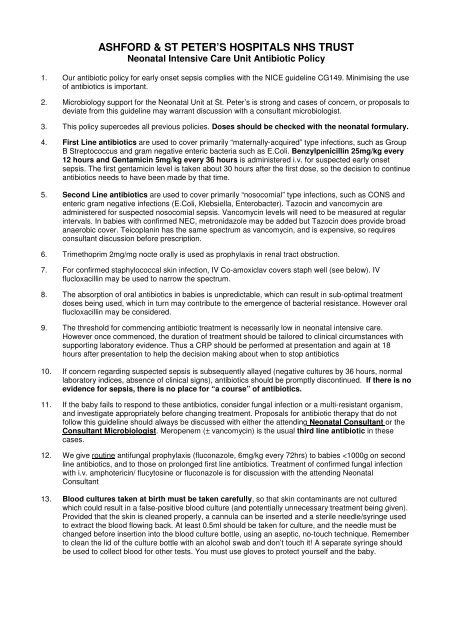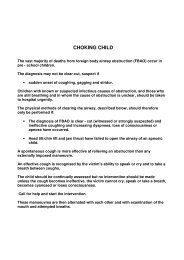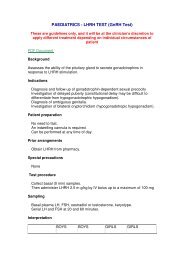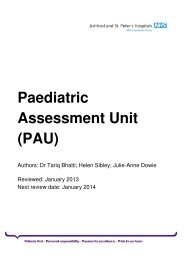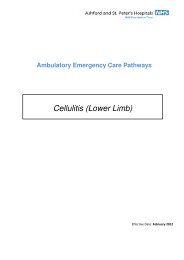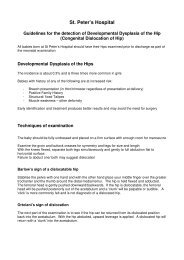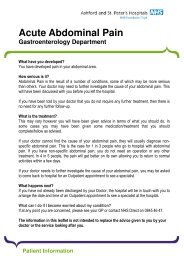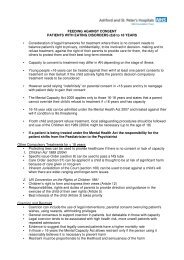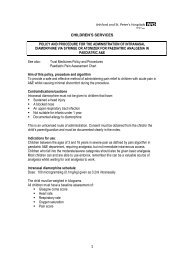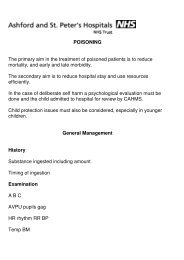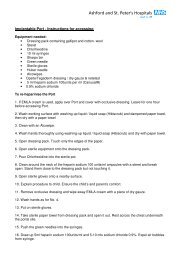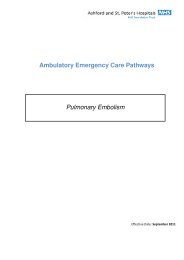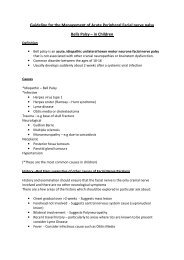Antibiotic Policy - Ashford and St. Peter's Hospitals NHS Trust
Antibiotic Policy - Ashford and St. Peter's Hospitals NHS Trust
Antibiotic Policy - Ashford and St. Peter's Hospitals NHS Trust
Create successful ePaper yourself
Turn your PDF publications into a flip-book with our unique Google optimized e-Paper software.
ASHFORD & ST PETER’S HOSPITALS <strong>NHS</strong> TRUSTNeonatal Intensive Care Unit <strong>Antibiotic</strong> <strong>Policy</strong>1. Our antibiotic policy for early onset sepsis complies with the NICE guideline CG149. Minimising the useof antibiotics is important.2. Microbiology support for the Neonatal Unit at <strong>St</strong>. Peter’s is strong <strong>and</strong> cases of concern, or proposals todeviate from this guideline may warrant discussion with a consultant microbiologist.3. This policy supercedes all previous policies. Doses should be checked with the neonatal formulary.4. First Line antibiotics are used to cover primarily “maternally-acquired” type infections, such as GroupB <strong>St</strong>reptococcus <strong>and</strong> gram negative enteric bacteria such as E.Coli. Benzylpenicillin 25mg/kg every12 hours <strong>and</strong> Gentamicin 5mg/kg every 36 hours is administered i.v. for suspected early onsetsepsis. The first gentamicin level is taken about 30 hours after the first dose, so the decision to continueantibiotics needs to have been made by that time.5. Second Line antibiotics are used to cover primarily “nosocomial” type infections, such as CONS <strong>and</strong>enteric gram negative infections (E.Coli, Klebsiella, Enterobacter). Tazocin <strong>and</strong> vancomycin areadministered for suspected nosocomial sepsis. Vancomycin levels will need to be measured at regularintervals. In babies with confirmed NEC, metronidazole may be added but Tazocin does provide broadanaerobic cover. Teicoplanin has the same spectrum as vancomycin, <strong>and</strong> is expensive, so requiresconsultant discussion before prescription.6. Trimethoprim 2mg/mg nocte orally is used as prophylaxis in renal tract obstruction.7. For confirmed staphylococcal skin infection, IV Co-amoxiclav covers staph well (see below). IVflucloxacillin may be used to narrow the spectrum.8. The absorption of oral antibiotics in babies is unpredictable, which can result in sub-optimal treatmentdoses being used, which in turn may contribute to the emergence of bacterial resistance. However oralflucloxacillin may be considered.9. The threshold for commencing antibiotic treatment is necessarily low in neonatal intensive care.However once commenced, the duration of treatment should be tailored to clinical circumstances withsupporting laboratory evidence. Thus a CRP should be performed at presentation <strong>and</strong> again at 18hours after presentation to help the decision making about when to stop antibiotics10. If concern regarding suspected sepsis is subsequently allayed (negative cultures by 36 hours, normallaboratory indices, absence of clinical signs), antibiotics should be promptly discontinued. If there is noevidence for sepsis, there is no place for “a course” of antibiotics.11. If the baby fails to respond to these antibiotics, consider fungal infection or a multi-resistant organism,<strong>and</strong> investigate appropriately before changing treatment. Proposals for antibiotic therapy that do notfollow this guideline should always be discussed with either the attending Neonatal Consultant or theConsultant Microbiologist. Meropenem (± vancomycin) is the usual third line antibiotic in thesecases.12. We give routine antifungal prophylaxis (fluconazole, 6mg/kg every 72hrs) to babies
References1. CG149 <strong>Antibiotic</strong>s for early-onset neonatal infection: NICE guideline www.nice.org.uk2. Selective fluconazole prophylaxis in high-risk babies to reduce invasive fungal infection” Archives ofDisease in Childhood - Fetal <strong>and</strong> Neonatal Edition 2007;92:F454-F458Guideline HistoryCompiled by: Dr Peter Reynolds, Consultant Neonatal PaediatricianReviewed by: Neonatal Clinical Management GroupUpdated by: Dr. Peter ReynoldsDate: May 2009, June 2010Ratified by: Dr. Peter Reynolds, Chair, Children’s Clinical Governance GroupDate: June 2010Review date: June 2013Updated: September 2012 in line with NICE guidance by Dr. Peter Reynolds


